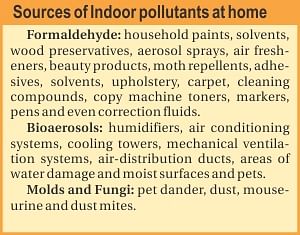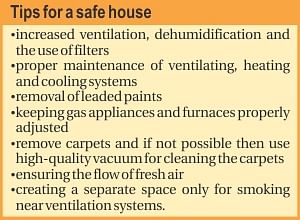| Home - Back Issues - The Team - Contact Us |
 |
| Volume 11 |Issue 18 | May 04, 2012 | |
|
|
Health Battling Indoor Pollution Obaidur Rahman The word “pollution” naturally shifts our attention towards the deterioration of outdoor environment that we live around. But the environmental status of the very home that we inhabit could be just as harmful as the outside since our standard household possessions are the sources of numerous contaminants that could put our health at great risk. The international recognition to the extent of this environmental problem dates back to only a few decades as scientists found out that indoor air levels of many pollutants may be two to five times, and on occasion more than one hundred times, higher than outdoor levels. And since people spend most of their lifetime in indoor surroundings, the level of health-risk due to toxins is very high, making our households and workplaces unfit for human habitation, if not properly maintained.
In the context of Bangladesh it is a great concern since research has found out that indoor air pollution is one of the leading causes of infant mortality, after water borne and sanitation related diseases. So, what are these indoor pollutants and where do these harmful contaminants generate from? Unfortunately, many modern household appliances that we use for convenience also serve as the 'point sources' of indoor pollution. To put it simply, the key pollutants and their sources of indoor pollution includes, the by-products of domestic combustions such as carbon monoxide, carbon dioxide and nitrous oxide from resources like oil, gas, kerosene, coal, wood and tobacco products. Formaldehyde, another indoor pollutant, results from pressed wood products (hardwood, plywood wall panelling, particleboard, and fibreboard) used in buildings and furniture. Contaminants like asbestos, which is a known human carcinogen, generate from deteriorating or damaged insulation, fireproofing, or acoustical materials and also from wet or damp carpets. The health effects of indoor pollution can range from short-term to even long-term problems depending on the duration of exposure to the pollutants. But generally the interim effects include eye, nose and throat irritation, headaches, coughing, fatigue, rashes, allergic reactions, loss of coordination and nausea. And long-term exposure to indoor pollution may lead to detrimental health effects like impaired lung and respiratory functions in children, bronchitis, flu-like symptoms, pneumonia, asthma, increased risk of ear infections in children and heart diseases amongst the adults, damage to kidney and central nervous system, excessive perspiration, humidifier fever, influenza to even lung and stomach cancer. It also has its psychological effects as well which includes lack of motivation, general feeling of poor health, poor performance (academic or professional), confusion to even depression.
The seriousness of the consequences of indoor pollution towards our health is seemingly grave because outdoor pollution provides the baseline of impact that's automatically going to be added on to whatever extent of pollution that we have inside. Considering Dhaka's worsening air pollution it sure is something that requires serious attention. According to one World Bank study, as many as 15,000 deaths a year, a million causes of major illness and 8.5 million cases of minor illnesses are caused by the air pollution in Bangladesh where most cases are from the capital itself. However, research carried out by World Bank and WHO in Bangladesh suggest that the status of indoor air pollution is more prominent in the rural and in the urban slum areas of the country and this is mostly due to the type of fuel used for cooking purposes and lack of proper ventilation system in those areas.
Evidently poverty plays a crucial role in worsening this situation as these poor communities mostly use biomass fuels for cooking and heating purposes which in fact, have very high concentration of harmful chemical compounds. The stoves that the people of these areas usually use are one burner stoves which usually cost less and converts energy at an efficiency rate of 12 to 18 percent. Studies also found out that women and young children of these communities are mostly exposed to this hazard that often results in severe health problems such as upper respiratory diseases and lung cancer. For the rural and urban slum households improved biomass stoves and cleaner fuels such as liquefied petroleum gas could be introduced however given the economic constraints both at the personal and national level, such transition is quite unfeasible at this stage. Perhaps a more reasonable solution from health, environmental and economic standpoints for these communities would be the improvement of ventilation systems that would make sure the smoke properly vents outside for good. The practice of keeping in-house plants must also be encouraged as inexpensive, ecologically sound and aesthetically pleasing plants like Boston Fern, English Ivy, Spider plant, Stripped dracaena, Chinese evergreen, Sansvieria (snake plant), Garbera, Golden pothos, Areca palm, Chrysanthemum, Bamboo palm, Aloe Vera and Spathyphyllum (peace Lilly) are some of the best defenses against harmful indoor pollutants like formaldehyde, carbon monoxide, xylene and benzene. It sure can be challenging to rid the house entirely of the pollutants but with efforts, the effects can be kept at minimum which will eventually ensure a healthy, environmentally sound and reinvigorated residence, a place we all would love to call “Home”.
Copyright
(R) thedailystar.net 2012 |


